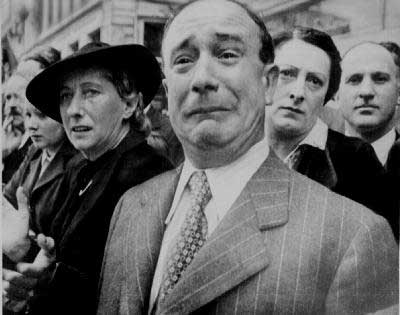
|
|
|
Monday 05 January 2004
Corporate Idiocy
Intellectual Property, Control, and Profit Last night’s not-very-good episode of The Simpsons features, at one point, Milhouse grimacing in a peculiar way.
This looked familiar, so I turned to the web. Eventually, I found the original image, and in fact The Simpsons had been more directly aping the original than I’d even thought:
This is a Frenchman watching the Germans march into Paris on 14 June 1940. Now, as it turns out, this photo is in the U.S. National Archives, apparently having been taken by an Army Signal Corps photographer who was in Paris when the Germans arrived. The Archives’ information on the provenance of this photo is sketchy. I began my search, though, assuming that this photo had been taken by a photographer for Life magazine, since many of the best photos of World War II originally appeared in Life. I did some poking around and eventually came across the Life magazine photo archive. There are actually two different Life photo archives online, depending on what you want. There’s this, a hosey Flash-based site touting prints of their photos. That is, for a price, you can purchase a copy of, say, Eisenstaedt’s famous photograph of a sailor kissing a nurse in Times Square, printed from the original negative. Pretty neat. Of course, you can’t just buy a print from them. They’ll sell only “to approved art and design trade accounts, including art and photography galleries, museum shops, corporations, lifestyle retailers, designers, and architects.” If you are not in this rarefied group, and if you don’t want to buy at least three photographs to begin with, they don’t want to hear from you. You must go through one of their authorized dealers, which are located in at least twelve states. Well, then. Oh, and the prices? I have to assume that it’s a matter of ‘if you have to ask, you can’t afford it’. Nowhere on their website do they give any indication of what you might pay for one of these prints once you track down a dealer. One wonders why they even have a website for this product, given that the main purpose of the site seems to be to tell you to go away. I’m wasn’t interested in buying a print, though; I just wanted to see the photograph in question, so I could compare it to The Simpsons. Time-Life’s picture digital picture archive is here, and it’s run by Getty Images. Trouble is, random members of the public can’t search the archive, and you can’t even browse more than a very few images. Eisenstaedt’s Times Square picture, probably the most-famous photo Life ever published, is nowhere to be found among the tiny thumbnails featured on the site. The site promises that you can search (and presumably see versions of the images large enough to distinguish details) if you register for an account; so I registered, supplying them with all kinds of personal information. A little while later, I got the following e-mail:
I have not yet been contacted, presumably because this is some process that requires the intervention of a human. So, their position is this: I can buy their images as photographic prints, but not directly from them; I have to jump through some specific hoops. I can, presumably, view their images online, and I can, for a price, use them in my creative works, but to even see whether one of their images will suit my purposes, I must establish an account with them — and establishing an account is not just a matter of signing up. Oh, and they look forward to providing me with ‘exceptional’ service. I would say that they’re already providing me with ‘exceptional’ service, as most people who are selling things are eager to do so. Tiffany’s will send you diamond rings in the mail, provided you can pay for them. A process that involves so many obstacles certainly is an exception. Presumably, Time-Life is hysterically paranoid about their images being ‘stolen’ and used without permission or payment, but I have to wonder whether this makes any sense at all. It’s not as if it’s in Time-Life’s interest to hold these images close to their vest; the main reason these images are so valuable in the first place is that hundreds of thousands of copies of the things were printed in magazines. Eisenstaedt’s Times Square photograph isn’t actually all that good a photo, particularly compared to the rest of his work: its importance and value comes almost entirely from the fact that nearly everyone has seen it, and that it symbolizes the end of World War II more clearly for most Americans than anything that happened on board the U.S.S. Missouri. And it’s not as if they have any hope of really capturing every last bit of potential revenue here. The Times Square photo is readily available at low resolutions online now, and I seriously doubt that all of these people have paid the license fee. Were Time-Life to attempt to collect licenses from people using the photo, most of those people would just take it down. If Time-Life were assiduous enough in their enforcement, they might manage to suppress the thing altogether, and create a generation of people who see that photo as nothing more than a couple of people kissing in the middle of the street. Part of the difficulty of valuing intellectual property is that exposure of the product — sale, piracy, whatever — carries an opportunity cost that’s almost impossible to accurately calculate. If I can see the Times Square photo for free, I’m a tiny bit less likely to buy an Eisenstaedt book, a small portion of the revenue from which goes to Time Warner. If I can buy it for $1.00, I’m less likely to buy it for $10.00 later. And so on. While it’s impossible to accurately calculate the opportunity cost of exposing intellectual property, nobody appears to even try to estimate the opportunity cost of keeping all this stuff locked up. It’s a Wonderful Life provides one of the very few examples of a quality media product that hasn’t been rigidly controlled for its entire existence. It’s a Wonderful Life isn’t the best movie ever made, but it’s certainly the best-known movie of 1946: The Best Years of Our Lives, a much better movie, won Oscars for Best Picture, Best Actor, Best Supporting Actor, Best Director, Best Screenplay, Best Editing, and Best Music in 1946, but most people today are not familiar with it. It almost certainly makes less money for MGM today than It’s a Wonderful Life does for Republic. In fact, It’s a Wonderful Life has probably made more money altogether, despite effectively having been in the public domain from 1974 to 1994, than The Best Years of Our Lives. Why is this? It’s because It’s a Wonderful Life was, for a time, a cultural artifact rather than a product. People now purchase it — either outright or by watching a broadcast with advertising — not because the information contained in the movie is otherwise unavailable to them, but precisely because it isn’t. It’s familiar; George Bailey’s wild run through the town, the halting Auld Lang Syne, Zuzu’s petals, and all the rest are part of the American Christmas tradition. The kid who works at the video store who had never heard of Citizen Kane and who told me that they probably didn’t have it because ‘it’s an old movie’ has undoubtedly seen It’s a Wonderful Life fifty times. There’s a value in that, and a value that can be measured in dollars. Unfortunately, most companies in the intellectual-property business show by their actions that they are more interested in having more iron-fisted control than they are in having more money. Posted by tino at 15:28 5.01.04This entry's TrackBack URL::
http://tinotopia.com/cgi-bin/mt3/tinotopia-tb.pl/226 Links to weblogs that reference 'Intellectual Property, Control, and Profit' from Tinotopia. Comments
None of my comments are related to the actual point of your post, but: My emotional reaction to the man in that photo is surprisingly intense. I can’t look at it without hurting. Looking at the still you captured, the similarities between the two photos are obvious, but I’m still amazed that you recognized what the Simpsons folks were doing. Aside from the man’s expression, which is well-done on Milhouse but still doesn’t really evoke the photo for me, the scene isn’t distinctive enough to me so that I would have recognized it in the cartoon. Posted by: Evelynne at January 9, 2004 11:20 AM As a tot, I spent a lot of time reading the Time-Life pictorial World War II series. There are better sources of information about World War II, I’m sure, but probably very few better sources of photographs of the war. Posted by: Tino at January 9, 2004 01:50 PM i really enjoy reading your blog as well as nicole’s, just curious how you searched for that pic, i’ve also been wondering if there is a site on the web where you can paste in a pic and search for a description instead of the other way around. thanks and keep up the great work Posted by: mike at January 14, 2004 06:51 PM I have been searching for a Life Magazine photo showing President Roosevelt with Japanese Americans who are giving the original straight-arm salute to the U.S. flag, as it was before a similar salute was used by the National Socialist German Workers Party. The photo was taken during the time of the Japanese-American internment. Examples of the eye-popping salute in photos are at http://members.ij.net/rex/pledge1.html Posted by: RexCurry.net at April 25, 2004 06:18 PM |

